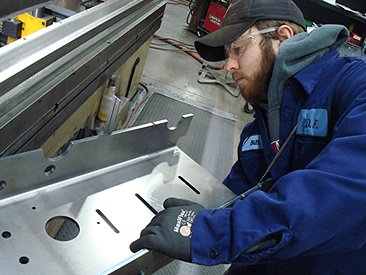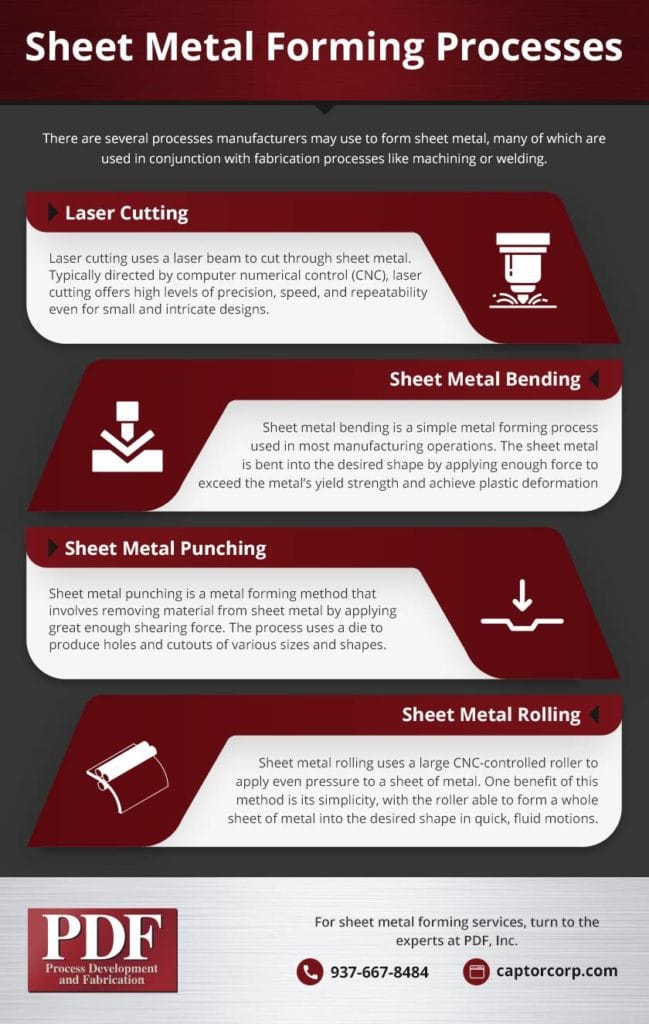
Sheet metal forming refers to the techniques a manufacturer uses to change the shape of sheet metal during production. The formed sheet metal can be sold as is for various uses by other manufacturers or it can be made into parts for machines, goods, or equipment. Sheet metal forming is compatible with many materials and encompasses a wide range of processes, including laser cutting, bending, punching, and rolling.
Sheet Metal Forming Processes
There are several processes manufacturers may use to form sheet metal, many of which are used in conjunction with fabrication processes like machining or welding to further change the shape of the metal and create different products. Sheet metal forming process include:
Laser Cutting
Laser cutting uses a laser beam to cut through sheet metal. Typically directed by computer numerical control (CNC), laser cutting offers high levels of precision, speed, and repeatability even for small and intricate designs. Laser cutting also produces flat components that can then be formed or bent through further forming processes.
Sheet Metal Bending
Sheet metal bending is a simple metal forming process used in most manufacturing operations. The sheet metal is bent into the desired shape by applying enough force to exceed the metal’s yield strength and achieve plastic deformation. This creates a permanent change in the part’s geometry in the form of a bend.
Sheet Metal Punching
Sheet metal punching is a metal forming method that involves removing material from sheet metal by applying great enough shearing force. The process uses a die to produce holes and cutouts of various sizes and shapes. The punch press directs the punch downward through the sheet and into the die below. This is done with enough speed and force to cause the material to quickly bend and fracture.
Although sheet metal punching is typically used to punch standard shapes, such as squares, circles, and rectangles, custom tooling can be made to produce more complex designs.
Sheet Metal Rolling
Sheet metal rolling uses a large CNC-controlled roller to apply even pressure to a sheet of metal. By doing this, the metal can be gradually drawn out into circular or conical shapes. One benefit of this method is its simplicity, with the roller able to form a whole sheet of metal into the desired shape in quick, fluid motions. The roller is also easy to adjust to achieve different thicknesses.
What Types of Metal Are Used in Sheet Metal Forming?
Sheet metal forming is compatible with many types of metal to suit the needs of various applications. Manufacturers often choose a metal based on which properties will best fit the needs of their particular project. Common metals for sheet metal forming include:
- Stainless steel
- Cold rolled steel (CRS)
- Galvanized steel
- Aluminum
Sheet Metal Forming from PDF, Inc.
Sheet metal forming is an umbrella term that encompasses a variety of techniques used to change the shape of sheet metal. Sheet metal forming is highly versatile and can be performed on a wide range of metals, making it a vital part of manufacturing in numerous industries. To learn more about sheet metal forming processes and their applications, contact PDF, Inc. today, or request a quote to get started on your next sheet metal forming project.

